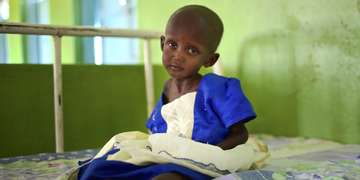For a Dollar a Day You Can Feed
x
EMERGENCY ALERT
7 million people in Somalia are right now suffering extreme hunger, with over 81,000 living in famine-like conditions.
Across the Horn of Africa, families in the grip of a devastating drought are skipping meals to feed their children, selling off all their assets, and even having to marry their young daughters to pay for food and medicine. Save the Children is on the ground providing water, seeds and health services. Your donation today to the Children's Emergency Fund supports this life-saving work.
Starving children in Africa are extremely vulnerable to disease. When malnutrition weakens a child, common illnesses become life-threatening. See how one child survived thanks to the caring professionals at a hospital supported by Save the Children's donors.
The Devastating Effects of Child Starvation & Malnutrition in Africa
Every child deserves a healthy start in life. However, there are far too many starving children in Africa for whom hunger is a constant, chronic pain.
In sub-Saharan Africa, a shocking 28 million children are experiencing stunted growth due to malnutrition. Stunting prevents children from developing to their full potential mentally and physically, and it is largely irreversible.
Stunting is not the only form of malnutrition that affects children. Children who have severe acute malnutrition, the deadliest form of extreme hunger, can succumb to the disease in just a few days. Children who die in this way suffer immensely as their vital organ functions slow down and eventually stop.
It doesn't have to be this way for children. We need your help to alleviate the hunger crisis in Africa today.
Starving Children in Africa Need Your Help Today
It's very simple – starving children in Africa need your help. Drought, poverty and conflict have impacted every aspect of their lives.
With your support, our frontline health teams are working across the continent to deliver emergency hunger and nutrition programs to save vulnerable children. Critically, we're also working to prevent malnutrition from occurring in the first place. But we can't do it without you!

Screening Children in Africa for Malnutrition
Small measuring tapes like these are a crucial part of Save the Children's malnutrition screening programs. Called MUAC (Mid-Upper Arm Circumference) tapes, they are very easy to use and can quickly deliver critical information. The bands are simply wrapped around the mid-point of the child's upper arm and, taking into account the child's ages, the circumference of their arm is measured against different colored zones on the band. Green is normal, yellow is moderately malnourished and red is severely malnourished. If children in the red zone are not quickly treated, there is a very real risk the child could die or suffer from profound long-term health and development issues.
How Much Does it Cost to Feed a Hungry Child?

$40 could buy a box of highly nutritious peanut paste to treat 1 child with severe acute malnutrition for 10 weeks.

$100 could cover all the costs for the treatment of one child with severe acute malnutrition, including costs such as routine medication, transportation and the cost of staff.

$210 could pay for a household to feed and protect livestock, which will ensure continued access to food and income for the household after the emergency.
African Countries Facing a Hunger Crisis
The world knows how to prevent child deaths due to hunger. In fact, more children are surviving today than at any time in history. The challenge is that proven lifesaving services aren't reaching the children most in need, including the poorest counties in Africa where nearly 52% of the world's poorest children live. Save the Children is working to change all this – and save more lives.

Somalia
More than half of children aged under five in Somalia are facing acute malnutrition, with one in six suffering from the most deadly form as time to fend off famine starts to run out.
Save the Children has worked in Somalia since 1951. This year, we have reached more than 24,000 people through cash programming and treated more than 50,000 children for malnutrition. We are currently providing water trucking to more than 25,000 households and unconditional cash provisions to nearly 11,000 households in the worst-affected areas.

South Sudan
The hunger crisis in South Sudan is especially dire, as roughly half the population is without enough food. Some 1.7 million people are facing emergency levels of hunger, which is one step away from famine. Nearly one million children under the age of five are acutely malnourished.
Our teams are working hard to screen children for malnutrition and help prevent the deadly diseases they are more likely to contract and die from, including measles, malaria, diarrhea, cholera and pneumonia.

Ethiopia
Children are still feeling the impact from the worst drought to hit Ethiopia in more than 50 years. Millions of families dependent on rain to grow crops for food and income remain at risk of extreme hunger and malnutrition. Additionally, the country is home to one of the largest populations of refugees.
Save the Children has worked to improve nutrition among the poorest Ethiopian children. Working very closely with the government, our teams are devising a national nutrition plan and responding quickly and efficiently to save as many lives as possible. We are also working with communities to improve their knowledge so that they are better equipped to protect themselves and their children from the effects of hunger. Our mobile health teams provide assessment and treatment of children suffering malnutrition.

Kenya
Successive droughts have made it hard for many families in Kenya to make a living. The number of people who don't know where their next meal is coming from and who are in need of assistance now stands at 2.55 million.
Save the Children's mobile health teams visit drought-affected communities in Kenya to not only treat children who are already sick but also to prevent further illness. We actively screen children under the age of five for malnutrition so that they can receive ready-to-use therapeutic foods such as a highly nutritious peanut paste. We also screen pregnant women and breastfeeding mothers. We also carry out community awareness activities across the whole community so that everyone understands the risks around malnutrition and disease.

Nigeria
Right now, 1.9 million people require urgent humanitarian assistance, as conflict and displacement has left countless families without food or basic necessities.
We're distributing food to vulnerable families, running feeding and treatment centers, in addition to providing psychosocial support.

Uganda
Uganda is now hosting more refugees than any nation in Africa, with over 1 million refugees, including children who've walked for days without food, water or rest.
We're at work in refugee sites, as well as in remote areas where health needs are highest and lives are on the line.

Niger
Save the Children has been running programs in Niger, one of the world's poorest countries, since the 2005 food crisis. In Niger, 42% of children under the age of five are stunted due to malnutrition. As a result, children are particularly vulnerable to dangerous, life-threatening diseases such as malaria, diarrhea, acute respiratory infections and anemia.
Save the Children is on the ground working to help Nigerien children and alleviate suffering among child refugees, returnees, internally displaced children and locals through health and nutrition programs, among others.
How Can You Help to Alleviate the Hunger Crisis in Africa?

Donate
Support Save the Children's mission. Donate to help hungry children in Africa, and around the world, survive and thrive.

Sponsor a Child in Africa
Be the hero in the life of a child in need. Sponsor a child in Africa and help them grow up healthy, educated and safe.

Shop Gift Catalog
Give a unique and meaningful gift that will bring joy – and change lives. Find something for everyone on your list.
Sources:
[i] UNICEF Accessed 24 March 2018
[ii] In 2015, the infant mortality rate for American Indians was 8.2, compared to 5.9 for the United States as a whole. Source: National KIDS COUNT Data Center Accessed 25 March 2018
[iii] Stop the War on Children report
[iv] 2019 Global Childhood Report
We'll be in touch! By signing up to receive emails from Save the Children you will receive a subscription to our monthly eNews, access to breaking emergency alerts and opportunities to get involved. To ensure delivery of Save the Children emails to your inbox, add support@savechildren.org to your contact list.
By providing my mobile phone number, I agree to receive recurring text messages from Save the Children (48188) and phone calls with opportunities to donate and ways to engage in our mission to support children around the world. Text STOP to opt-out, HELP for info. Message & data rates may apply. View our Privacy Policy at savethechildren.org/privacy.
Source: https://www.savethechildren.org/us/what-we-do/emergency-response/helping-starving-african-children
0 Response to "For a Dollar a Day You Can Feed"
Post a Comment